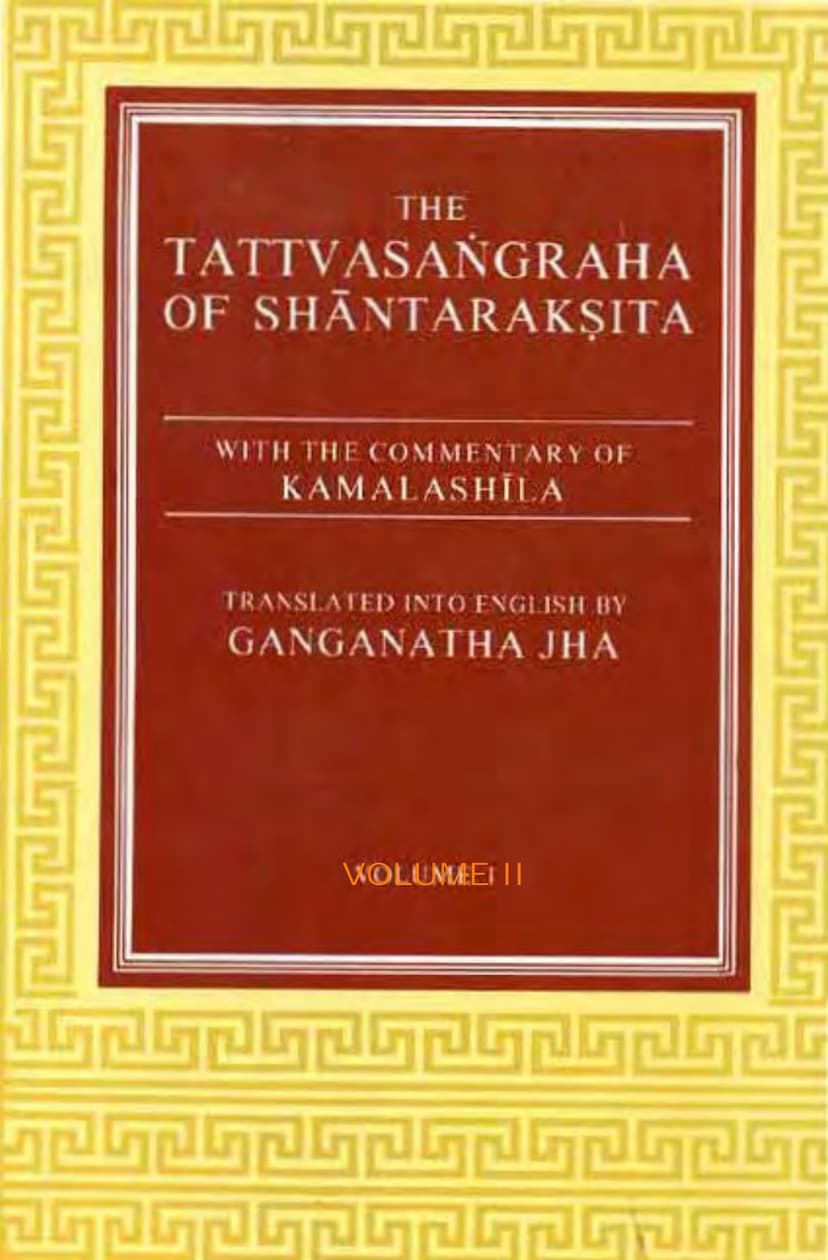Tattva Sangraha Vol 2
Added to library: September 2, 2025

Summary
Here's a comprehensive summary of the provided English translation of the Tattvasangraha, Volume II, focusing on the content and arguments presented:
Overall Purpose and Context:
The Tattvasangraha, with Kamalasila's commentary, translated by Ganganatha Jha, is a monumental work of Buddhist philosophy that systematically examines and refutes the views of various other philosophical schools (heterodox and orthodox Indian traditions) to establish the validity of Buddhist (specifically Madhyamaka and Yogachara) tenets. Volume II, as presented, delves into the various means of knowledge (Pramanas) and specific doctrines, engaging in detailed dialectical arguments.
Key Themes and Arguments Explored in Volume II (Based on the provided text, primarily Chapter XIX onwards):
Chapter XIX: Other Forms and Means of Knowledge
This chapter meticulously analyzes and refutes various proposed means of knowledge beyond the two accepted by Buddhists (perception and inference, though their definition of these is also debated).
- Verbal Cognition (Shabda Pramana):
- The text argues against verbal cognition being a distinct means of knowledge, identifying it with inference.
- It challenges the Buddhist claim of verbal cognition derived from eternal sentences or trustworthy persons.
- Arguments focus on the lack of the three features of inference (hetu, sadhya, sadhya-hetu sambhandha) in verbal testimony.
- The eternality and all-pervasiveness of words are questioned.
- The role of convention in language and meaning is debated.
- The validity of words from trustworthy persons is challenged due to the impossibility of definitively ascertaining trustworthiness.
- Analogical Cognition (Upamana):
- The text presents and critiques the Mimamsaka view of analogy (upamana), which is often seen as a form of verbal cognition or remembrance.
- It debates whether similarity is a distinct entity or a relationship.
- The argument explores how similarity is perceived and whether it can be a valid means of knowledge distinct from perception and inference.
- Presumption (Arthāpatti):
- The text examines the Mimamsaka concept of Arthāpatti as a distinct means of knowledge, where an inexplicable fact leads to the assumption of another fact.
- Examples from perception, inference, and verbal cognition are analyzed.
- The validity of presumption is questioned, particularly its distinction from inference due to the perceived lack of concomitance.
- Specific examples are used to dissect the logical structure and potential fallacies of presumption.
- Negation (Abhāva):
- The Mimamsaka view of Abhāva as a distinct means of knowledge is explored.
- The debate centers on whether negation is an entity, its fourfold classification (previous, destruction, mutual, absolute negation), and its relationship to other means of knowledge.
- The text argues that negation is not a distinct means but is either included within perception or leads to logical problems like infinite regress or mutual dependence.
- Yukti (Ratiocination) and Anupalabdhi (Non-apprehension):
- These are examined as potential distinct means of knowledge.
- The text argues that ratiocination is essentially a form of inference, and non-apprehension is either subsumed under perception or leads to logical issues.
- Sambhava (Probability) and Aitihya (Tradition):
- These are briefly considered and dismissed as either inferential or unreliable.
- Pratibha (Intuition):
- Intuition is examined, with the critique that such sudden cognitions are often found to be false or unreliable, and their validity is questioned.
- Lokāyata (Materialism):
- The text engages with the materialist position that reality is solely composed of material substances and that consciousness arises from these.
- It refutes the materialist denial of the afterlife, soul, and karma.
- Arguments focus on the impossibility of consciousness arising from material substances, the lack of continuity between bodies, and the inherent flaws in their denial of a beginningless and endless self or consciousness.
- External World (Bāhyārtha):
- This section critiques the Buddhist Idealist position that only consciousness exists and the external world is a mere projection of the mind.
- Arguments are presented to defend the reality of the external world, often through examining the nature of perception, atoms, and the impossibility of pure consciousness without an external object.
- The text delves into the concept of atoms, their potential divisibility, and the philosophical implications of their existence or non-existence.
- The Revealed Word (Shabda Pramana):
- This is a significant portion dedicated to the Mimamsaka defense of the Vedas as an eternal and authoritative source of knowledge.
- Arguments revolve around the eternality of the word-sound (shabda), its inherent expressiveness, the impossibility of convention, and the nature of recognition.
- The text meticulously refutes Buddhist and other arguments that question the Veda's authority, including the absence of a personal author, the possibility of falsity, and the potential for misinterpretation.
- It analyzes the relationship between words and their meanings, the role of the auditory organ, and the nature of perception in understanding language.
- The Mimamsaka perspective on the eternality of the word and its relation to the concept of the universal (jāti) is explored.
- The arguments often involve complex logical maneuvers and the identification of fallacies in the opponent's reasoning.
Methodology and Style:
- Polemical: The text is highly polemical, engaging in rigorous debate with opposing philosophical viewpoints.
- Analytical and Dialectical: It systematically presents arguments, counter-arguments, and refutations, often exploring multiple alternatives.
- Reference to Authorities: It frequently cites and engages with the views of prominent philosophers like Shabara, Kumarila Bhatta, Dinnāga, and others, often quoting from their works.
- Logical Scrutiny: The core of the work lies in its detailed logical analysis of concepts, definitions, and inferential reasoning (pramana).
- Detailed Examination: The approach is exhaustive, leaving no stone unturned in dissecting the logical underpinnings of each philosophical position.
In essence, Volume II of the Tattvasangraha, as represented by this excerpt, is a deep dive into epistemological and metaphysical debates within Indian philosophy, showcasing the Buddhist attempt to establish its own worldview by systematically dismantling the arguments of its rivals, particularly the Mimamsakas. The text highlights the complexity and sophistication of Indian philosophical discourse, demonstrating a profound engagement with logic and conceptual analysis.